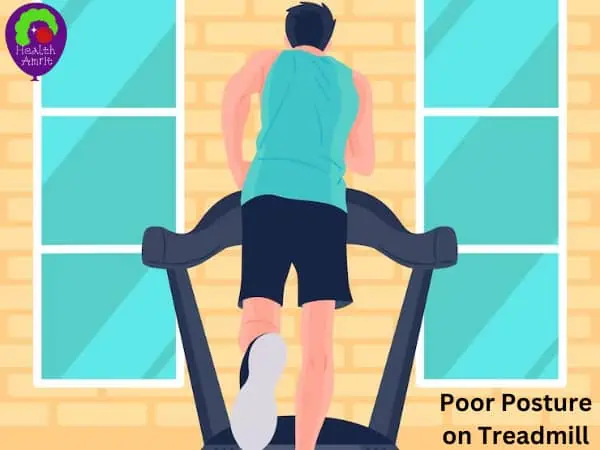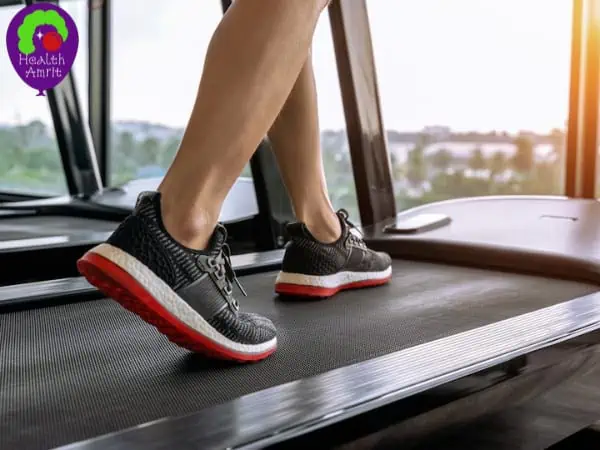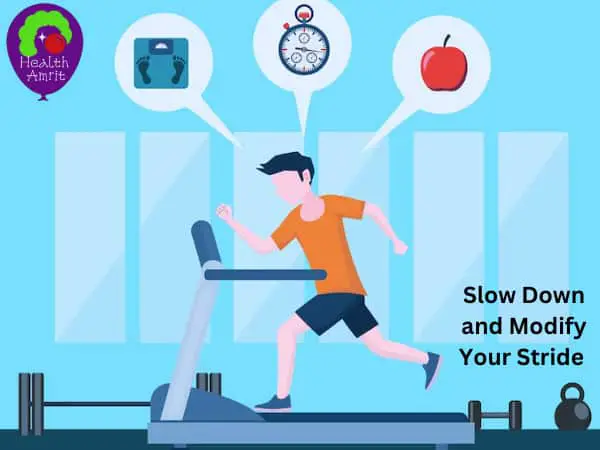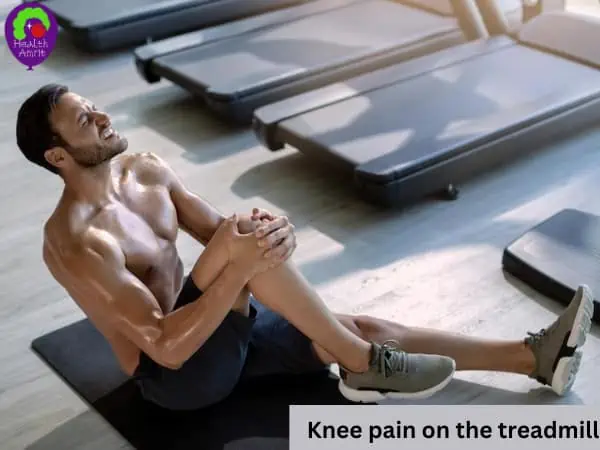Exercise helps strengthen you, enhance your balance, and minimize knee pain if you have arthritis pain. A simple, low-impact exercise, to begin with, is walking. No matter the weather conditions, you can walk on a treadmill, and your joints won’t move any differently than they would if you were outdoors.
A top-rated treadmill is a fantastic method to get your usual cardio without having to go outdoors to run. Depending on a machine can be considerably more convenient, whether you’re working out in the winter or prefer to use your home gym. Excruciating knee discomfort is a significant problem that many men and women have when they begin using treadmills.
Causes Of Knee Pain From A Treadmill
Several things you might be doing wrong could be the root cause of your knee pain after utilizing the treadmill. It’s possible that you need the appropriate sneakers or that your current pair needs to be replaced.
Additionally, your stance or stride length during running may be off. Another option is that you have an unbalanced physique from having tight muscles, which prevents you from distributing the force of running equally through all of the bones in your body.
Poor Posture
One of the leading causes of knee pain on the treadmill is faulty running kinematics and poor standing posture.
Joint pain can result from improper impact distribution caused by poor posture. The vertebral column should be tall and straight while running, and your abdomen must be contracted. Your upper body should be relaxed and away from your ears.
Poor posture will cause your joints to misalign, making it difficult for the human body to absorb the impact of running. Your knees, hips, and spine may be put under unfavorable strain.

Unsuitable Shoes
Improper footwear can cause knee pain on the treadmill, shin splints, and blisters, increasing your chances of foot pain and blisters. Running shoes are thoughtfully constructed to offer the right support and shock mitigation.
But only some runners respond well to every shoe. Jogging shoes are built of lighter-weight materials and include cushioning to lessen the pressure of jogging on your joints compared to conventional sneakers.
Depending on a person’s pronation, which determines how the foot hits the ground during running, running shoes have varying levels of cushioning.
The outermost part of your back heel strikes the ground first when you pronate normally if your arch is regular; after that, your foot rotates inward to make full contact with the ground’s surface
Excessive Incline or Decline
When jogging uphill, your knees accommodate your ankle joints, moving less when running at an elevation. Your sore knees may experience undue strain, which can be very painful.
The same is true for excessive downhill movement, which can put undue strain on the ligaments in your lower body and knee joints.
Your feet should land under you while sprinting rather than in front of you, and your legs should be bent at a roughly 90-degree angle. You can efficiently move forward using your body weight once your foot touches the ground.
However, if your foot strikes in front of you, the force of your forward repetitive motion will strain your knees.

Tight Muscles
The patella, or kneecap, can become misaligned when your quadriceps are tight, leading to stiffness in your leg and stress on the knee joint.
Tight IT belts increase friction, which can cause leg pain and swelling in the knee’s outer region. Add endurance workouts to your pre-and post-workout regimen as a start. You are less prone to sustain injuries the more agile you are.
Additionally, stretching after exercise aids in releasing lactic acid, preventing your muscles from tightening and becoming sore after a terrific run.
Faulty Treadmill Mechanics
The treadmill you’re using might need improvement. Producers of treadmills are creating new technology to lessen the stress running has on your joints because it is one of the most frequent injuries runners face.
Although some treadmill designs are intended to be less taxing on your body than standard concrete, it’s vital to remember that they are less supported than grass or a track.
If you exercise in a gym or at home, test out several elliptical machines and read evaluations of the best gym equipment to discover the one that best suits your needs. Additionally, keep up with servicing to help your treadmill maintain its integrity over time.

Runner’s Knee
The most appropriate course of action if you have a runner’s knee is to cease running for a few days and perform lower-impact workouts like swimming, kayaking, or walking until the condition improves.
If you have bad knees, taking more pauses is an excellent choice because the longer you run, the more pressure you put on them. Go for three 20-minute sessions or four 15-minute runs if your daily running goal is 60 minutes.
This will allow you to complete the required number of runs and cardiovascular eccentric exercises for the day while still giving you time to recover between those runs.
Ways to Alleviate Knee Pain From a Treadmill
Stretch Before and After Your Run
The knee soreness from treadmill running might be lessened by stretching before and after your run. Begin with some warm-up exercise, like a leisurely jog or walk before your planned run.
After a brief warm-up, perform dynamic stretches concentrating on the tissues supporting your knees, including your hamstrings, quadriceps, and calves.
These stretches will help you enhance your range of motion and boost blood flow to your muscles, which helps lessen the strain on your knees when you’re running. While jogging, be cautious to keep your knees in a neutral position.
Avoid taking excessive steps or landing on your heels to prevent excessive impact on your knees.

Correct Your Posture
Your knees will experience less stress if you run on the treadmill with good posture. With your shoulders back and your head turned forward, stand up straight.
While running, try to avoid slouching or leaning excessively forward or backward, as this might put stress on your knees. Keep your hips aligned with your knees and ankles while maintaining core stability.
Get Properly Fitted Shoes
Proper footwear is crucial to avoid chronic knee pain level while running on a treadmill. Shoes that fit correctly give you the support and cushioning you need to lessen the impact of each step on your knees.
When you visit a specialty running store, have your feet, arch, and running style measured by a professional shoe fitter.
Finding shoes that fit correctly and give your feet and knees the support they need might be much easier with this.
However, speaking with a sports doctor or physical therapist for a proper diagnosis and treatment is crucial if you continue to experience knee discomfort despite taking these precautions.
To help relieve knee discomfort and avoid further common running injury, they could suggest extra exercises, stretches, or therapies.

Adjust Your Treadmill Mechanics
Knee discomfort can be decreased, and treadmill exercises can be more comfortable by adjusting your treadmill’s mechanics.
Try lowering the gradient to relieve knee pain because a steeper incline can put additional strain on your knees as your knees strengthen over time, gradually up the incline.
You can ease knee pain on the treadmill and improve the comfort of your treadmill eccentric exercises by modifying your treadmill’s mechanics. However, you should speak with a sports doctor to rule out any underlying issues if your knee pain persists despite these changes.
Slow Down and Modify Your Stride
Slowing down and changing your stride can assist in lessening the impact on your knees and relieve discomfort if you’re suffering knee pain when running. Your knees may be less likely to be impacted if you take fewer steps.
To keep your speed, try taking smaller steps and quickening your cadence. To lessen the force on your knees, try landing on your midfoot rather than your heel.
Pay attention to landing gently and bending your knee just enough to absorb impact. A modest forward lean can assist in lessening the force on your knees.
Leaning too far forward might strain your knees, so keep it in check. Take stops during your run to stretch and recover if you have knee pain.

Engage in Preventative Stretching
Preventive stretching helps lessen knee discomfort by enhancing flexibility and easing muscle stress.
Stretching can help to warm up and cool down the muscles before and after eccentric exercise, lowering the chance of common injury and minimizing pain.
Stretches that specifically target the knee’s surrounding Leg muscles, like hamstring and quadruple poses, can increase flexibility and ease tension in the knee joint.
Stretching can assist in avoiding the onset of knee pain relief by incorporating it into your routine.
Utilize Pain Alleviation Techniques
Knee pain can be relieved with various pain management treatments, including cooling, heat therapy, and over-the-counter painkillers.
Heat therapy can stimulate blood flow and relax the muscles, while applying ice to the affected area can help reduce inflammation and numb the discomfort. Ibuprofen and other over-the-counter pain relievers can also assist in lessening discomfort and inflammation.
Before using any painkillers, it’s crucial to consult your family doctor.
Mix Up Your Exercise Routine
By decreasing repetitive stress on the knee joint, changing your exercise program can assist in alleviating knee pain.
Exercises with low impacts, like swimming and cycling, can lessen the strain on the knee joint while still being effective.
Exercises for strength training can also support the knee joint and reduce knee pain. Knee discomfort can be relieved, and injury risk can be decreased by including a range of daily activities in your program.
Warm Up, Cool Down, and Stretch Properly
By preparing the muscles for eccentric exercise and releasing the tension, proper warm-up, cool-down, and stretching can assist in preventing knee pain.
Spend some time warming up with easy workouts like cycling or walking before commencing your workout. This will improve muscle blood flow and prepare them for harder exercise.
Spend some time cooling down with easy exercises and stretches after your workout. Your heart rate will gradually drop, and blood won’t accumulate in your legs.
Finally, stretching can help to ease muscle tension and lower the risk of injury after exercise. To alleviate knee discomfort, concentrate on extending the muscles that surround the knee, such as the hamstrings and quadriceps.

Consider a Better Treadmill
A better treadmill can aid in alleviating knee discomfort by offering a more cushioned surface and lowering impact on the knees.
Shock absorption technology, which can lessen the impact on your knees and help you avoid damage, is something to look for in a treadmill.
A treadmill with changeable incline levels is another option to consider because it can help you change the intensity of your workout and lessen the strain on your knees.
The treadmill must also be regularly oiled and maintained because one that is not can do more harm than good. A better treadmill may lessen knee pain and enhance your workout.
FAQs about Knee Pain From a Treadmill
Is it Advisable to Walk on the Treadmill with Knee Pain?
It depends on how bad the knee pain is. In some circumstances, using a treadmill to walk on can assist in reducing stiffness and increase blood flow to the muscles, which can help to relieve knee discomfort. Walking on a treadmill, however, might aggravate knee discomfort if it is severe. Before beginning any workout program, speaking with your sports doctor is crucial, especially if you are experiencing knee pain.
When Should I Seek Medical Attention for Knee Pain?
If your knee discomfort is severe, lasts longer than a few days, or is exacerbated by inflammation, redness, or warmth in the afflicted area, you should consult a sports doctor.
Additionally, you should consult a doctor if you have trouble putting any weight on the injured knee or if it feels unstable or gives way under your weight.
What Should I Do if My Knees Do Not Stop Hurting?
It’s crucial to consult your healthcare practitioner if your knee pain persists. Your healthcare practitioner can suggest suitable treatment alternatives and assist you in identifying the underlying cause of your knee discomfort.
Knee pain may be relieved in some cases by rest and ice, but in other circumstances, more intensive care, such as physical therapy or surgery, may be required.
How Can I Prevent Knee Pain From a Treadmill?
Several techniques to avoid knee pain when using a treadmill include:
-
- Wearing the right shoes
-
- Modifying the pace and slope
-
- Warming up and stretching properly before working out
Additionally, it’s critical to pay attention to your body’s signals and stop exercising if you feel any pain or discomfort. Last, keep the treadmill well-maintained and greased to avoid machine wear and tear, which can worsen knee discomfort.
Why Does My Inner Knee Hurt After Walking on the Treadmill?
An injury or excessive use of the knee joint frequently results in inner knee pain after treadmill walking. In particular, when the treadmill is set to a high slope or speed, the inner knee is prone to strain and damage.
If you have recurrent knee discomfort, it’s vital to speak with your doctor since they can assist in identifying the underlying problem and suggest the best course of action.
How Can I Strengthen My Knees on a Treadmill?
Several strategies to strengthen your knees on a treadmill include:
-
- Adding hills and incline levels to your workout.
-
- Doing resistance band training exercises.
-
- Employing good form and technique when walking or running.
Furthermore, it’s crucial to warm up and stretch properly before beginning your workout because doing so might reduce the risk of chronic injury and knee joint stress.
To avoid overuse injuries and knee pain, it’s crucial to start carefully and gradually increase your workout intensity and duration. Speak to your healthcare provider or a certified fitness professional if you have any worries or inquiries.
How Often is it Safe to Walk on the Treadmill?
Your age, health, and degree of fitness affect how frequently you use a treadmill. Most people can safely use a treadmill for at least 30 minutes daily, several days a week.
However, paying attention to your body and beginning carefully, building up the length and intensity of your physical level of activity over time, is crucial.
To avoid damage and strain on the knee joint, it’s vital to warm up and stretch properly before beginning your body workout.
What Are the Most Common Treadmill Knee Injuries?
Runner’s knee, patellofemoral pain (PFPS) syndrome, and iliotibial Resistance band syndrome are the most frequent knee ailments sustained using a treadmill. (ITBS).
Overuse, poor form or technique, or abrupt increases in workout intensity or duration are common causes of these injuries.
Pain, edema, and stiffness in the knee joint are signs of these injuries. If you have recurrent knee discomfort, it’s vital to speak with your doctor since they can assist in identifying the underlying problem and suggest the best course of action.
Should I Wear a Knee Brace on the Treadmill?
The individual and their particular requirements will determine whether or not they should use a knee brace on the treadmill.
For people with knee injuries or who experience chronic knee discomfort, knee braces can give additional support and stability to the knee joint.
Knee braces should not be used as a band-aid fix for underlying knee issues; nevertheless, they do not replace good form and technique. To find out if a knee brace is an appropriate choice for you and to ensure that it is properly fitted and used, speak with your healthcare practitioner or a licensed fitness expert.


